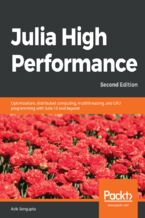Those who are new to Julia often ask me what makes it so special, or how it achieves such high performance. Having to think on my feet in order to answer this question has proven challenging. This was the case, at least, until Avik Sengupta came along with the Julia High Performance book. Now all I have to do is tell the enquirers to read the book as it consists of just the right combination of details to answer their questions.
In an easy-to-read concise set of chapters - most of which contain words like "performance" and "fast" - Avik takes you through examples that you can run yourself in order to see how fast and easy Julia is to use.
There are computer science words that have become Julia words. It is a pleasure to learn these in a manner that is easy to follow. Just a few examples of this are "JIT", "Multiple Dispatch", "type system", "generated functions", "CUDA", and "SIMD".
After learning about Julia's design, you will learn to measure performance. From there, you will appreciate Julia's type system. You will then master using arrays along with making fast function calls and fast numbers. Finally, you will learn to write parallel Julia programs.
With Julia High Performance, you'll pick up the key essentials of Julia in no time. You can then join the friendly, fast growing, online community of Julia programmers.
Welcome to the world of Julia! Read this book and you will soon join us in loving the Julia language.
Alan Edelman
Professor of Applied Mathematics
Computer Science & AI Labs Member
MIT
Co-creator, The Julia Language




